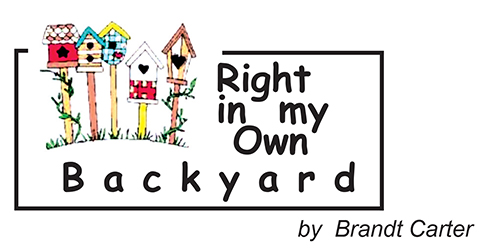
|
Broad Ripple Random Ripplings

The news from Broad Ripple
Brought to you by The Broad Ripple Gazette
(Delivering the news since 2004, every two weeks)

|
| Brought to you by: |

|

|

|

|

|

|
Converted from paper version of the Broad Ripple Gazette (v11n20)
Right in my Own Backyard - Word to the Wise - by Brandt Carter
posted: Oct. 03, 2014

Word to the Wise
When in doubt, leave that feather on the ground. There are laws and treaties dating back to the early 1900s that protect birds, especially the American Bald Eagle, our national bird. The Lacey Act prohibits trafficking of live or dead wildlife specimens, declaring it a felony if you try. The Migratory Bird Treaty protects almost all North American birds except game birds. You cannot pursue, hunt, take, capture, kill, possess, sell, barter, purchase, ship, export, or import any migratory birds nor any part, nest, eggs or products thereof. The treaty goes on to specify that feathers are included and are protected, even if they were naturally molted. This also includes use on antique items such as hats and taxidermy items.
Didn't I say, "Don't pick it up?" The more recent protection most of us are familiar with is The Endangered Species Act that relates to endangered or threatened species. If violated, perpetrators can be charged with misdemeanor criminal penalties. So now that we can't even pick up a protected bird for study or collecting, let's have a summer lesson on bird feathers.
Bird feathers are fascinating. They are complex, light weight, and awesomely efficient. There are six different types of feathers. Flight feathers enable flying and are most visible to us. Contour feathers give birds shape and color. At the base, feathers becomes downy and help insulate. Down feathers are soft and fluffy. Semiplume feathers are usually found underneath contour feathers, providing insulation. Near the mouth and eyes are Bristle feathers, and Filoplume feathers are attached to birds' nerve endings.
So what do feathers do beside cover birds and enable flight? Feathers keep birds warm. If you observe birds at your feeders in the winter, they will fluff their feathers to keep themselves warm. Feathers provide insulation, helping to control body temperature -- both cooling and warming. These amazing body parts help protect birds from wind, moisture, and sun. They are so strong, with interlocking barbs and oils, that some birds are waterproof (look at the ducks in the Canal). They use their wings to swim and dive. With lightweight bodies and hollow wing veins, birds are quite buoyant.
Bracing is another use of feathers by some birds. Observe woodpeckers as they use their tail feathers to support themselves on the ground or when they skirt up and down trees. Feathers can work as feeling sensors. Although the feathers don't have nerves, they do have a sensory function where they attach, much like whiskers on a cat. Owls arrange their facial feathers to enhance and collect sounds so they can hone in on their prey. And finally, some birds can actually make different sounds like humming, drumming, and whistling with their feathers.
Birds also line their nests with their own feathers; hummingbirds use their head feathers to pollinate flowers; herons may shade their heads with their feathers so they can see fish in the water easier; and owls use their wing feathers to muffle their flight sound. Feathers can be camouflage, send visual come hither cues to mates, signal rivals, or provide fright molt by dropping some tail feathers to distract a predator. While tending their nest, many birds soak their belly feathers and use the water to keep their eggs from drying out or give their brood a bit of water. Amazing!
Considering all this information about feathers, I'm looking at birds even more admiringly these days. I hope you will be doing the same.
Brandt Carter, artist, herbalist, and naturalist, owns Backyard Birds at 2374 E. 54th Street. Visit her web site www.feedbackyardbirds.com. Email your bird questions to Brandt@BroadRippleGazette.com
brandt@broadripplegazette.com

|

|

|
| Brought to you by: |

|

|

|
| Brought to you by: |

|

|

|
| Brought to you by: |

|

|

|
| Brought to you by: |


